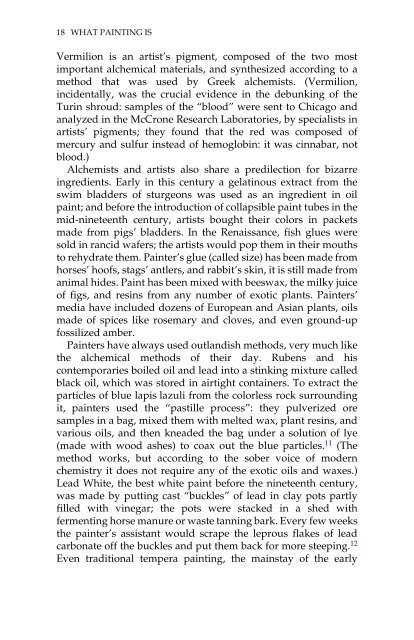What Painting Is: How to Think about Oil Painting ... - Victoria Vesna
What Painting Is: How to Think about Oil Painting ... - Victoria Vesna
What Painting Is: How to Think about Oil Painting ... - Victoria Vesna
You also want an ePaper? Increase the reach of your titles
YUMPU automatically turns print PDFs into web optimized ePapers that Google loves.
18 WHAT PAINTING IS<br />
Vermilion is an artist’s pigment, composed of the two most<br />
important alchemical materials, and synthesized according <strong>to</strong> a<br />
method that was used by Greek alchemists. (Vermilion,<br />
incidentally, was the crucial evidence in the debunking of the<br />
Turin shroud: samples of the “blood” were sent <strong>to</strong> Chicago and<br />
analyzed in the McCrone Research Labora<strong>to</strong>ries, by specialists in<br />
artists’ pigments; they found that the red was composed of<br />
mercury and sulfur instead of hemoglobin: it was cinnabar, not<br />
blood.)<br />
Alchemists and artists also share a predilection for bizarre<br />
ingredients. Early in this century a gelatinous extract from the<br />
swim bladders of sturgeons was used as an ingredient in oil<br />
paint; and before the introduction of collapsible paint tubes in the<br />
mid-nineteenth century, artists bought their colors in packets<br />
made from pigs’ bladders. In the Renaissance, fish glues were<br />
sold in rancid wafers; the artists would pop them in their mouths<br />
<strong>to</strong> rehydrate them. Painter’s glue (called size) has been made from<br />
horses’ hoofs, stags’ antlers, and rabbit’s skin, it is still made from<br />
animal hides. Paint has been mixed with beeswax, the milky juice<br />
of figs, and resins from any number of exotic plants. Painters’<br />
media have included dozens of European and Asian plants, oils<br />
made of spices like rosemary and cloves, and even ground-up<br />
fossilized amber.<br />
Painters have always used outlandish methods, very much like<br />
the alchemical methods of their day. Rubens and his<br />
contemporaries boiled oil and lead in<strong>to</strong> a stinking mixture called<br />
black oil, which was s<strong>to</strong>red in airtight containers. To extract the<br />
particles of blue lapis lazuli from the colorless rock surrounding<br />
it, painters used the “pastille process”: they pulverized ore<br />
samples in a bag, mixed them with melted wax, plant resins, and<br />
various oils, and then kneaded the bag under a solution of lye<br />
(made with wood ashes) <strong>to</strong> coax out the blue particles. 11 (The<br />
method works, but according <strong>to</strong> the sober voice of modern<br />
chemistry it does not require any of the exotic oils and waxes.)<br />
Lead White, the best white paint before the nineteenth century,<br />
was made by putting cast “buckles” of lead in clay pots partly<br />
filled with vinegar; the pots were stacked in a shed with<br />
fermenting horse manure or waste tanning bark. Every few weeks<br />
the painter’s assistant would scrape the leprous flakes of lead<br />
carbonate off the buckles and put them back for more steeping. 12<br />
Even traditional tempera painting, the mainstay of the early


